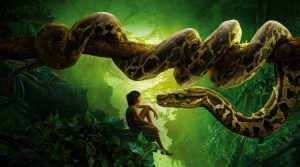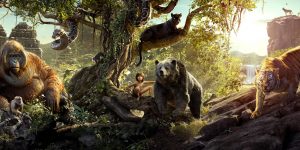Interview: Chris Glass of “The Jungle Book”
Posted on August 29, 2016 at 3:45 pm

“It’s kind of funny,” Glass told me, “because Jon Favreau, Bill Pope, Rob Legato, me, everyone working on the movie, all of us come from the same philosophy where more practical is better. You know we talked about CG movies, movies that were mostly done on the computer and the shortcomings or the strengths, what works and what doesn’t work, and then it’s kind of ironic because we’re making a movie that’s 98 percent computer generated. But I think that is actually good that we all had this healthy skepticism of the technology. Rob Legato is a master of the technology and so is Andy Jones the animator and Adam Valdez and Dan Lemmon. So really what we needed on this movie was kind of that spirit of doing things practically but yet we knew that a lot of it wasn’t going to be practical. But having said that there was a lot of practical stuff but it was all snippets and slices of sets and a prop sometimes like a cow bell would be real, like the stuff around Mowgli inside King Louie’s Temple next to him is real. We had some real fruit on the ground. We threw real fruit out of a fruit launcher when he throws the fruit down on the ground. But there’s some CG. You don’t know where the line begins or ends and that was kind of our intention. Jon wanted to blur the line between reality and what we create in the computer. We wanted to be fooled ourselves.”
In a non CG film you can see the footage immediately after it has been filmed. But because of all the effects, the crew would not see what the scenes looked like for months. “It wasn’t like the next day you would see the finished shot; it was an iterated thing. So our challenge was to see if we could fool one another and there were times when we were fooled, and sometimes it would be the reverse, sometime Jon would be like, ‘Oh that is so fake’, but it would be real. I would say, ‘No that’s actually my set.’ He would be like, ‘Oh, that’s the fakest part’ and I’d be ‘Oh no.’ It felt sometimes like it was backwards. There were literally times I was designing sets after we had already shot the scene physically and edited it then I would design the set; it was very odd.”
Ultimately the real and virtual worlds were so integrated that it was hard to tell where the line was. “Basically anything Mowgli is touching is mostly real. If his feet are touching it or his hands are touching it, but not always. The animals aren’t real, some trees are definitely not but a lot of the plants and the things he’s walking through are, and even the grass he is walking through when he is talking to Bagheera. We built a little strip of grass like 4 feet wide for him to walk through. Technically it served the purpose of giving him interaction. If you have to animate everything that the kid is touching and everything it would have made his task even more daunting than it already was. And if you do end up replacing stuff it’s a great lighting reference and physical interaction reference for the animator so that they can copy that when they are doing the rest of it so that it behaves in the same way or looks the same.”

Glass was very impressed with Neel Sethi, the young actor who played Mowgli, and how natural he was even when he had to imagine how it would all look. “A lot of the stuff he did do completely with nothing but blue and he did a great job. I think even well-seasoned actors have more trouble. A kid is pretending and he’s cool with it. He was talking to the puppets and it worked.”
Glass had been to India and other jungles before. “And we did have a team that went out and took at least 80,000 photographs of India. We had research that were on for many, many months; we just researched everything that we could. We used the Internet, we used books, we called consulates, we talked to directors who were shooting. There was the “Monkey Kingdom” movie that was shot in Sri Lanka and India. We talked to them about monkeys, how they behave and what kind of places they lived and they showed us their footage. We discovered the pangolin, the weird-looking scaly animal that’s highly endangered and I said, ‘Oh let’s put that in the movie.’ We took some liberties but we really tried to keep everything as something that could be realistically found in India. Now obviously we have exaggerated sizes, and we created a world that was more like the composite of India because the kid really couldn’t walk from a really jungle area to a really desert-y area overnight like that. In reality that would take months and weeks. And we looked at the Disney ’67 movie and we had to incorporate the feeling much of that film, too. It’s more colorful, with more flowers, more whimsy and I had to bring that into the real rendering of the plants and things. We tried to find the balance of where it starts to looked too weird, where it looked good. So it was all just a lot of experimentation and a lot of research.”
